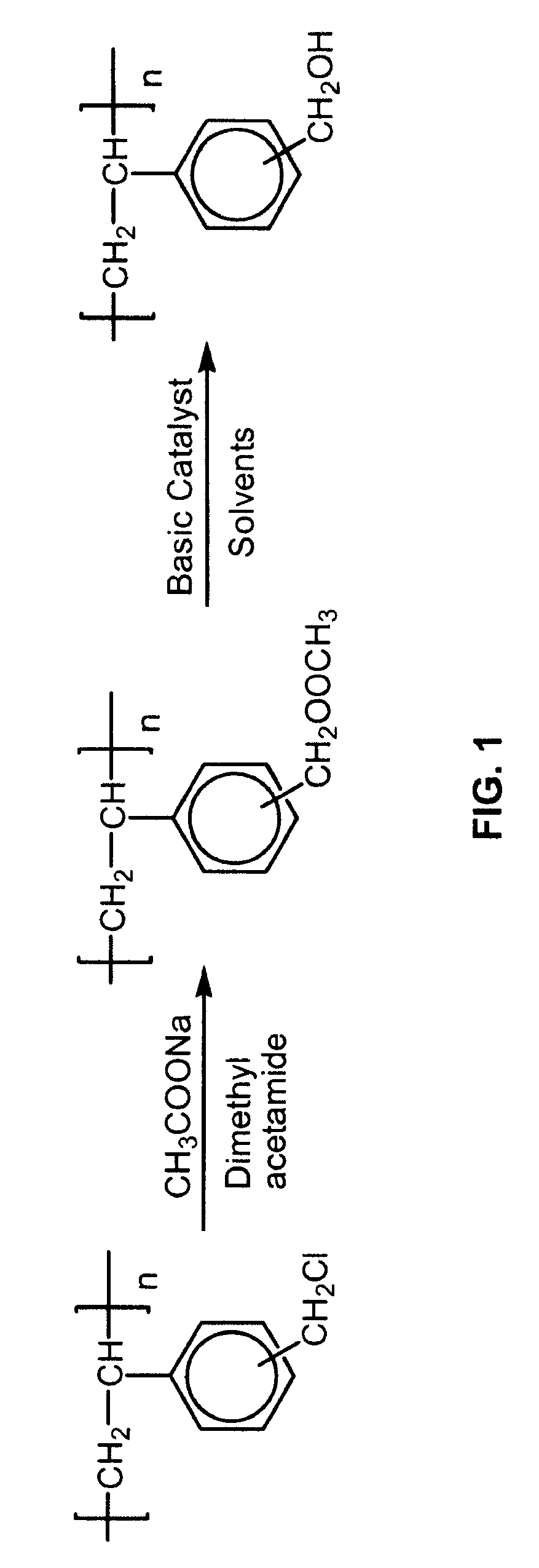Polymer processes
a polymer and alcohol technology, applied in the field of polymer alcohol preparation, can solve the problems of difficulty in separating vinylbenzyl chloride, low overall yield of about 5%, crosslinking of poly, etc., and achieve the effect of facilitating scaling up
- Summary
- Abstract
- Description
- Claims
- Application Information
AI Technical Summary
Benefits of technology
Problems solved by technology
Method used
Image
Examples
example 1
Preparation of Poly(Vinylbenzyl Acetate)
[0031]Poly(vinylbenzyl chloride) (200 grams) and 200 grams of sodium acetate in 4 liters of in N,N-dimethylacetamide were heated in a 5-liter, 3-neck flask under argon equipped with a mechanical stirrer, reflux condenser, argon inlet and stopper for 24 hours, using a silicone oil bath at 90° C. The resultant solution was decanted and separated from the salts that crystallized on cooling and was added to water at a ratio of 25 ml of polymer solution for every 1 liter of water using a Waring blender that was speed controlled with a variable transformer (Variac). The precipitated polymer was collected by filtration, washed with water and then with methanol (2 gallons). The aggregated lump that formed was vacuum dried to yield poly(vinylbenzyl acetate) with a glass transition temperature (Tg) of about 38° C. The lump was broken with a hammer and pulverized to a fine powder with a Waring blender. Although the conversion of chloromethyl groups to ac...
example 2
Preparation of Poly(Vinylbenzyl Alcohol)
[0032]Poly(vinylbenzyl acetate) (10 g) in anhydrous tetrahydrofuran (Aldrich, 100 grams) was stirred in a 500 ml, 3-neck round-bottom flask. The reaction vessel was equipped with a mechanical stirrer, reflux condenser and argon inlet and was situated in a silicone oil bath. The solution was heated at reflux until a solution is effectuated. Heating and reflux begin before addition of the organic base as provided below and continue until the polymer was completely dissolved. Benzyltrimethylammonium hydroxide (5 ml at 40 wt % in methanol) was then added. On addition of the base, the polymer precipitated. Water (5 ml) was added and there was no change of the appearance of the precipitate. Methanol (50 ml) was added to the mixture and the precipitate immediately dissolved. After 2.5 hours at reflux with stirring, the reaction mixture was added to water at a ratio of 25 ml of polymer solution for every 1 liter of water using a Waring blender control...
example 3
Scale-Up of the Preparation of Poly(Vinylbenzyl Alcohol)
[0033]Poly(vinylbenzyl acetate) (1520 grams or 8.64 moles) and tetrahydrofuran (10 kg) were placed in a 22 liters, 3-necked round-bottom flask equipped with a mechanical stirrer, an addition funnel (1 liter), and an inert gas inlet. The mixture was heated to reflux for 15 min and 750 grams of 5% sodium methoxide in methanol was added over a period of 10 minutes. To redissolve the precipitated polymer, 2000 grams of methanol were added to the flask and refluxed for an additional 3 hours. The solution was precipitated into 10× excess deionized water, washed 3 times with additional water and dried at about 50° C. under vacuum for about 48 hours. The polymer was then washed with methylene chloride and dried. The yield was 1138 grams of an off-white powder (about 98% of a weight basis with poly(vinylbenzyl acetate).
PUM
| Property | Measurement | Unit |
|---|---|---|
| temperature | aaaaa | aaaaa |
| reaction time | aaaaa | aaaaa |
| temperature | aaaaa | aaaaa |
Abstract
Description
Claims
Application Information
 Login to View More
Login to View More - R&D
- Intellectual Property
- Life Sciences
- Materials
- Tech Scout
- Unparalleled Data Quality
- Higher Quality Content
- 60% Fewer Hallucinations
Browse by: Latest US Patents, China's latest patents, Technical Efficacy Thesaurus, Application Domain, Technology Topic, Popular Technical Reports.
© 2025 PatSnap. All rights reserved.Legal|Privacy policy|Modern Slavery Act Transparency Statement|Sitemap|About US| Contact US: help@patsnap.com


